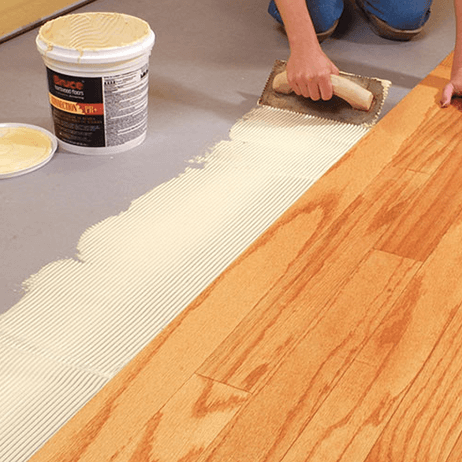
In the previous post, we presented different installation methods for your flooring. In part one, we introduced you to floating installation as a method of fixing your floor. We talked about how it works, as well as its advantages and disadvantages of floating floor installation. In the next step, we will look at glue-down installation as a permanent method for new flooring.
You can install different kinds of floorings with glue-down flooring method. Parquet flooring, Laminate, Luxury vinyl tiles, Engineered wood flooring are are available in glue-down method.
There are countless reasons why people choose glue down flooring as their preferred method of floor installation. While we will get to the pros and cons in a moment, let’s first look at what an glue-down flooring is.
As with all installation methods, you need to make sure that the floor is perfectly even. Glue is often used when you plan to install flooring on concrete or wood . To ensure longevity and high quality, a strong glue for wood floors is needed. The glue is then applied to the floor in small and workable pieces. This is done to ensure that the glue dosnt dries ahead of time. As with any wooden floor, care must be taken to ensure that a sufficient expansion joint remains.
Glue down flooring can technically be used in a variety of wood flooring applications. However, it is most commonly used in solid wood flooring that does not have a click or tongue and groove system. While these systems can be used in floors, they are often not cost effective due to the additional materials and time required for installation.
When installing over concrete, it is very important to make sure there is no moisture in the floor. Even the smallest amount can cause problems in the future. If you cannot be sure that there is no moisture present, you can use a liquid dehumidifying membrane before gluing down your floor. This will apply a protective layer to the wood that will prevent moisture from penetrating.
Glue down installation should not be confused with tongue and groove gluing, which is often found in wood flooring. While you can glue tongue and groove together, it is not recommended to glue the wood under the floor as well. This is because wood floors need room to move when they expand. If the wood is glued to the floor as well as between the planks, there will be no room to move.
In the long run, restricted movement will cause cracking, warping and twisting of your wooden floor. Therefore, it is better to use a floating floor if you stick to tongue and groove. If you glue the floor down, do not glue your planks together to achieve the necessary movement.
Glued down installation is a popular method of fixing, and you cannot deny the quality it brings to a brand new wood floor. If you need any further information, our helpful team are on hand to provide you with all the information you need. Call +61 1300 707 366 or email info@floorset.com.au today.